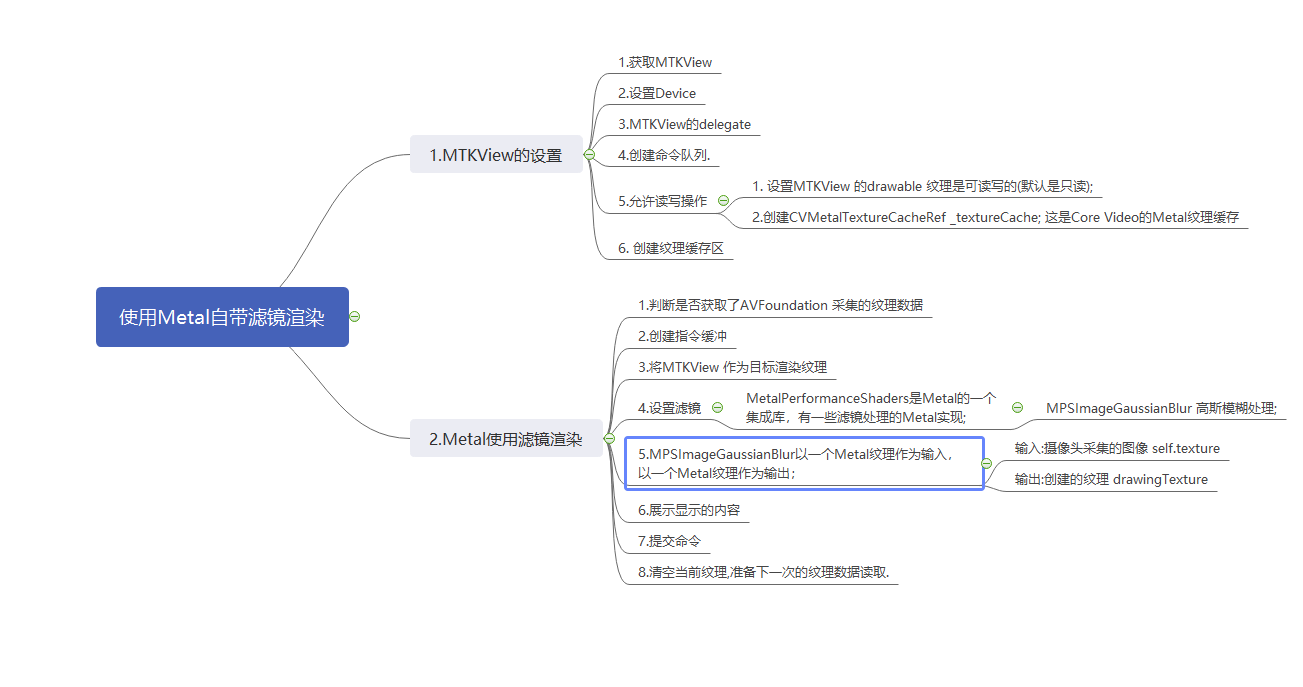本案例实现使用Metal利用摄像头采集的内容进行实时渲染。
思路:
- 使用AVFundation采集视频,并将原始数据传入到CMSempleBuffer中。CMSempleBuffer存储的是每一帧的数据。
- 使用CoreVideo处理CMSempleBuffer中的数据,将每一帧转成Metal需要的纹理。
- 使用Metal进行渲染。
1、 AVFundation采集视频
初始化视频采集的准备工作,以及开始视频采集,主要分为以下几步:
部分函数解析:
- 创建串行队列
串行队列创建的目的在于处理captureSession的交互时,不会影响主队列,在苹果官方文档中,表示captureSession是如何管理设备的输入 & 输出,以及与主队列之间的关系
self.mProcessQueue = dispatch_queue_create("mProcessQueue", DISPATCH_QUEUE_SERIAL);
- 设置输入设备
获取前/后置摄像头设备AVCaptureDevice;
通过摄像头设备创建AVCaptureDeviceInput;
输入设备添加到captureSession中;
//3.获取摄像头设备(前置/后置摄像头设备)
NSArray *devices = [AVCaptureDevice devicesWithMediaType:AVMediaTypeVideo];
AVCaptureDevice *inputCamera = nil;
//循环设备数组,找到后置摄像头.设置为当前inputCamera
for (AVCaptureDevice *device in devices) {
if ([device position] == AVCaptureDevicePositionBack) {
inputCamera = device;
}
}
//4.将AVCaptureDevice 转换为AVCaptureDeviceInput
self.mCaptureDeviceInput = [[AVCaptureDeviceInput alloc] initWithDevice:inputCamera error:nil];
//5. 将设备添加到mCaptureSession中
if ([self.mCaptureSession canAddInput:self.mCaptureDeviceInput]) {
[self.mCaptureSession addInput:self.mCaptureDeviceInput];
- 输入与输出链接 & 设置视频输出方向
通过AVCaptureConnection链接输入和输出,并设置connect的视频输出方向,即设置videoOrientation属性
// 8、输入与输出链接
AVCaptureConnection *connection = [self.mCaptureDeviceOutput connectionWithMediaType:AVMediaTypeVideo];
// 9、设置视频输出方向
//注意: 一定要设置视频方向.否则视频会是朝向异常的.
[connection setVideoOrientation:AVCaptureVideoOrientationPortrait];
示例代码:(示例代码使用的OC)
//1.创建mCaptureSession
self.mCaptureSession = [[AVCaptureSession alloc] init];
//设置视频采集的分辨率
self.mCaptureSession.sessionPreset = AVCaptureSessionPreset1920x1080;
//2.创建串行队列
self.mProcessQueue = dispatch_queue_create("mProcessQueue", DISPATCH_QUEUE_SERIAL);
//3.获取摄像头设备(前置/后置摄像头设备)
NSArray *devices = [AVCaptureDevice devicesWithMediaType:AVMediaTypeVideo];
AVCaptureDevice *inputCamera = nil;
//循环设备数组,找到后置摄像头.设置为当前inputCamera
for (AVCaptureDevice *device in devices) {
if ([device position] == AVCaptureDevicePositionBack) {
inputCamera = device;
}
}
//4.将AVCaptureDevice 转换为AVCaptureDeviceInput
self.mCaptureDeviceInput = [[AVCaptureDeviceInput alloc] initWithDevice:inputCamera error:nil];
//5. 将设备添加到mCaptureSession中
if ([self.mCaptureSession canAddInput:self.mCaptureDeviceInput]) {
[self.mCaptureSession addInput:self.mCaptureDeviceInput];
}
//6.创建AVCaptureVideoDataOutput 对象
self.mCaptureDeviceOutput = [[AVCaptureVideoDataOutput alloc] init];
/*设置视频帧延迟到底时是否丢弃数据.
YES: 处理现有帧的调度队列在captureOutput:didOutputSampleBuffer:FromConnection:Delegate方法中被阻止时,对象会立即丢弃捕获的帧。
NO: 在丢弃新帧之前,允许委托有更多的时间处理旧帧,但这样可能会内存增加.
*/
[self.mCaptureDeviceOutput setAlwaysDiscardsLateVideoFrames:NO];
//这里设置格式为BGRA,而不用YUV的颜色空间,避免使用Shader转换
//注意:这里必须和后面CVMetalTextureCacheCreateTextureFromImage 保存图像像素存储格式保持一致.否则视频会出现异常现象.
[self.mCaptureDeviceOutput setVideoSettings:[NSDictionary dictionaryWithObject:[NSNumber numberWithInt:kCVPixelFormatType_32BGRA] forKey:(id)kCVPixelBufferPixelFormatTypeKey]];
//设置视频捕捉输出的代理方法
[self.mCaptureDeviceOutput setSampleBufferDelegate:self queue:self.mProcessQueue];
//7.添加输出
if ([self.mCaptureSession canAddOutput:self.mCaptureDeviceOutput]) {
[self.mCaptureSession addOutput:self.mCaptureDeviceOutput];
}
//8.输入与输出链接
AVCaptureConnection *connection = [self.mCaptureDeviceOutput connectionWithMediaType:AVMediaTypeVideo];
//9.设置视频方向
//注意: 一定要设置视频方向.否则视频会是朝向异常的.
[connection setVideoOrientation:AVCaptureVideoOrientationPortrait];
//10.开始捕捉
[self.mCaptureSession startRunning];
2.Metal纹理

每当AVFundation采集到每一帧数据时都会执行代理方法,纹理由每一帧数据处理后生成的,所以纹理的生成在此代理方法中。
AVFundation的代理方法
- (void)captureOutput:(AVCaptureOutput *)captureOutput didOutputSampleBuffer:(CMSampleBufferRef)sampleBuffer fromConnection:(AVCaptureConnection *)connection {}
部分函数解析:
- 从现有图像缓冲区创建核心视频Metal纹理缓冲区。
将每一帧的数据从缓存中复制到Metal的纹理缓冲区。
参数1: allocator 内存分配器,默认kCFAllocatorDefault
参数2: textureCache 纹理缓存区对象
参数3: sourceImage 视频图像缓冲区
参数4: textureAttributes 纹理参数字典.默认为NULL
参数5: pixelFormat 图像缓存区数据的Metal 像素格式常量.注意如果MTLPixelFormatBGRA8Unorm和摄像头采集时设置的颜色格式不一致,则会出现图像异常的情况;
参数6: width,纹理图像的宽度(像素)
参数7: height,纹理图像的高度(像素)
参数8: planeIndex.如果图像缓冲区是平面的,则为映射纹理数据的平面索引。对于非平面图像缓冲区忽略。
参数9: textureOut,返回时,返回创建的Metal纹理缓冲区。
// Mapping a BGRA buffer:
CVMetalTextureCacheCreateTextureFromImage(kCFAllocatorDefault, textureCache, pixelBuffer, NULL, MTLPixelFormatBGRA8Unorm, width, height, 0, &outTexture);
// Mapping the luma plane of a 420v buffer:
CVMetalTextureCacheCreateTextureFromImage(kCFAllocatorDefault, textureCache, pixelBuffer, NULL, MTLPixelFormatR8Unorm, width, height, 0, &outTexture);
// Mapping the chroma plane of a 420v buffer as a source texture:
CVMetalTextureCacheCreateTextureFromImage(kCFAllocatorDefault, textureCache, pixelBuffer, NULL, MTLPixelFormatRG8Unorm width/2, height/2, 1, &outTexture);
// Mapping a yuvs buffer as a source texture (note: yuvs/f and 2vuy are unpacked and resampled -- not colorspace converted)
CVMetalTextureCacheCreateTextureFromImage(kCFAllocatorDefault, textureCache, pixelBuffer, NULL, MTLPixelFormatGBGR422, width, height, 1, &outTexture);
- 返回纹理缓冲区的Metal纹理对象。
将临时的纹理对象赋值到全局的纹理对象。
CVMetalTextureGetTexture(tmpTexture);
示例代码:(示例代码使用的OC)
//AVFoundation 视频采集回调方法
- (void)captureOutput:(AVCaptureOutput *)captureOutput didOutputSampleBuffer:(CMSampleBufferRef)sampleBuffer fromConnection:(AVCaptureConnection *)connection {
//1.从sampleBuffer 获取视频像素缓存区对象
CVPixelBufferRef pixelBuffer = CMSampleBufferGetImageBuffer(sampleBuffer);
//2.获取捕捉视频的宽和高
size_t width = CVPixelBufferGetWidth(pixelBuffer);
size_t height = CVPixelBufferGetHeight(pixelBuffer);
/*3. 根据视频像素缓存区 创建 Metal 纹理缓存区
CVReturn CVMetalTextureCacheCreateTextureFromImage(CFAllocatorRef allocator, CVMetalTextureCacheRef textureCache,
CVImageBufferRef sourceImage,
CFDictionaryRef textureAttributes,
MTLPixelFormat pixelFormat,
size_t width,
size_t height,
size_t planeIndex,
CVMetalTextureRef *textureOut);
功能: 从现有图像缓冲区创建核心视频Metal纹理缓冲区。
参数1: allocator 内存分配器,默认kCFAllocatorDefault
参数2: textureCache 纹理缓存区对象
参数3: sourceImage 视频图像缓冲区
参数4: textureAttributes 纹理参数字典.默认为NULL
参数5: pixelFormat 图像缓存区数据的Metal 像素格式常量.注意如果MTLPixelFormatBGRA8Unorm和摄像头采集时设置的颜色格式不一致,则会出现图像异常的情况;
参数6: width,纹理图像的宽度(像素)
参数7: height,纹理图像的高度(像素)
参数8: planeIndex.如果图像缓冲区是平面的,则为映射纹理数据的平面索引。对于非平面图像缓冲区忽略。
参数9: textureOut,返回时,返回创建的Metal纹理缓冲区。
// Mapping a BGRA buffer:
CVMetalTextureCacheCreateTextureFromImage(kCFAllocatorDefault, textureCache, pixelBuffer, NULL, MTLPixelFormatBGRA8Unorm, width, height, 0, &outTexture);
// Mapping the luma plane of a 420v buffer:
CVMetalTextureCacheCreateTextureFromImage(kCFAllocatorDefault, textureCache, pixelBuffer, NULL, MTLPixelFormatR8Unorm, width, height, 0, &outTexture);
// Mapping the chroma plane of a 420v buffer as a source texture:
CVMetalTextureCacheCreateTextureFromImage(kCFAllocatorDefault, textureCache, pixelBuffer, NULL, MTLPixelFormatRG8Unorm width/2, height/2, 1, &outTexture);
// Mapping a yuvs buffer as a source texture (note: yuvs/f and 2vuy are unpacked and resampled -- not colorspace converted)
CVMetalTextureCacheCreateTextureFromImage(kCFAllocatorDefault, textureCache, pixelBuffer, NULL, MTLPixelFormatGBGR422, width, height, 1, &outTexture);
*/
CVMetalTextureRef tmpTexture = NULL;
CVReturn status = CVMetalTextureCacheCreateTextureFromImage(kCFAllocatorDefault, self.textureCache, pixelBuffer, NULL, MTLPixelFormatBGRA8Unorm, width, height, 0, &tmpTexture);
//4.判断tmpTexture 是否创建成功
if(status == kCVReturnSuccess)
{
//5.设置可绘制纹理的当前大小。
self.mtkView.drawableSize = CGSizeMake(width, height);
//6.返回纹理缓冲区的Metal纹理对象。
self.texture = CVMetalTextureGetTexture(tmpTexture);
//7.使用完毕,则释放tmpTexture
CFRelease(tmpTexture);
}
}
3. 渲染

MTKView的设置是前期准备工作:
创建纹理缓冲区:
- 参数1: allocator 内存分配器.默认即可.NULL
- 参数2: cacheAttributes 缓存区行为字典.默认为NULL
- 参数3: metalDevice
- 参数4: textureAttributes 缓存创建纹理选项的字典. 使用默认选项NULL
- 参数5: cacheOut 返回时,包含新创建的纹理缓存。
CVMetalTextureCacheCreate(NULL, NULL, self.mtkView.device, NULL, &_textureCache);
示例代码:(示例代码使用的OC)
//1.获取MTKView
self.mtkView = [[MTKView alloc] initWithFrame:self.view.bounds];
self.mtkView.device = MTLCreateSystemDefaultDevice();
[self.view insertSubview:self.mtkView atIndex:0];
self.mtkView.delegate = self;
//2.创建命令队列.
self.commandQueue = [self.mtkView.device newCommandQueue];
//3.注意: 在初始化MTKView 的基本操作以外. 还需要多下面2行代码.
/*
1. 设置MTKView 的drawable 纹理是可读写的(默认是只读);
2. 创建CVMetalTextureCacheRef _textureCache; 这是Core Video的Metal纹理缓存
*/
//允许读写操作
self.mtkView.framebufferOnly = NO;
/*
CVMetalTextureCacheCreate(CFAllocatorRef allocator,
CFDictionaryRef cacheAttributes,
id <MTLDevice> metalDevice,
CFDictionaryRef textureAttributes,
CVMetalTextureCacheRef * CV_NONNULL cacheOut )
功能: 创建纹理缓存区
参数1: allocator 内存分配器.默认即可.NULL
参数2: cacheAttributes 缓存区行为字典.默认为NULL
参数3: metalDevice
参数4: textureAttributes 缓存创建纹理选项的字典. 使用默认选项NULL
参数5: cacheOut 返回时,包含新创建的纹理缓存。
*/
CVMetalTextureCacheCreate(NULL, NULL, self.mtkView.device, NULL, &_textureCache);
渲染:MTKView的delegate方法 -> drawInMTKView
使用Metal滤镜:
- MetalPerformanceShaders是Metal的一个集成库,有一些滤镜处理的Metal实现;
- MPSImageGaussianBlur 高斯模糊处理; sigma值可以修改,sigma值越高图像越模糊;
MPSImageGaussianBlur *filter = [[MPSImageGaussianBlur alloc] initWithDevice:self.mtkView.device sigma:1];
示例代码:(示例代码使用的OC)
- (void)drawInMTKView:(MTKView *)view {
//1.判断是否获取了AVFoundation 采集的纹理数据
if (self.texture) {
//2.创建指令缓冲
id<MTLCommandBuffer> commandBuffer = [self.commandQueue commandBuffer];
//3.将MTKView 作为目标渲染纹理
id<MTLTexture> drawingTexture = view.currentDrawable.texture;
//4.设置滤镜
/*
MetalPerformanceShaders是Metal的一个集成库,有一些滤镜处理的Metal实现;
MPSImageGaussianBlur 高斯模糊处理;
*/
//创建高斯滤镜处理filter
//注意:sigma值可以修改,sigma值越高图像越模糊;
MPSImageGaussianBlur *filter = [[MPSImageGaussianBlur alloc] initWithDevice:self.mtkView.device sigma:1];
//5.MPSImageGaussianBlur以一个Metal纹理作为输入,以一个Metal纹理作为输出;
//输入:摄像头采集的图像 self.texture
//输出:创建的纹理 drawingTexture(其实就是view.currentDrawable.texture)
[filter encodeToCommandBuffer:commandBuffer sourceTexture:self.texture destinationTexture:drawingTexture];
//6.展示显示的内容
[commandBuffer presentDrawable:view.currentDrawable];
//7.提交命令
[commandBuffer commit];
//8.清空当前纹理,准备下一次的纹理数据读取.
self.texture = NULL;
}
}
最后
以上就是爱笑枕头最近收集整理的关于Metal(五) 案例之视频采集与实时渲染的全部内容,更多相关Metal(五)内容请搜索靠谱客的其他文章。
本图文内容来源于网友提供,作为学习参考使用,或来自网络收集整理,版权属于原作者所有。








发表评论 取消回复